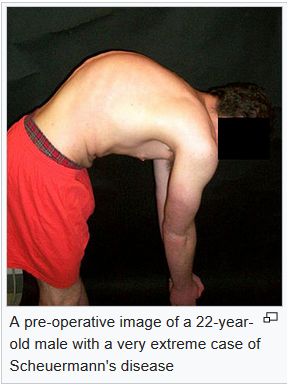nalco group
bone, muscle & joint pain physio
BOOK NOW / WHATSAPP ABOUT YOUR PAIN OR INJURY
- ORCHARD 400 Orchard Road #12-12 Singapore 238875
- TAMPINES 9 Tampines Grande #01-20 Singapore 528735
- SERANGOON 265 Serangoon Central Drive #04-269 Singapore 550265
Home > Blog > Spinal Physiotherapy > Scheuermann’s Kyphosis
Scheuermann’s Kyphosis

Scheuermann's Kyphosis is a developmental disorder that leads to patients developing a bent/stooped posture due to an excessive curve in the thoracic spine.
See our thoracic spine has a normal slight bend (medically termed as "kyphosis") but in Scheuermann's Kyphosis, it's much more (see image above). It refers to a condition that tends to happen moreso in one's adolescent (teenage) years, usually at the end of the growth years/age.
It's more prevalent in males compared to females, and affects about 0.5% of the population in general.
Scheuermann's Kyphosis is a Genetic Condition?
Unfortunately, the exact cause of Scheuermann's Kyphosis is still unsure, but is theorized to be a genetic condition which leads to unusual growth of the growth plate of the vertabrae, and the theory is that the growth rate of the front of the growth plate is slower compared the the back growth, hence it wedges forward.
Most of the time, Scheuermann's kyphosis appears in the thoracic (ribcage vertebrae) which cannot be corrected naturally. Patients who suffer from Scheuermann's kyphosis will have a deep/big hump (medically termed as "gibbus") when they bend forward.
At the very tip of the curve may be painful and in some conditions it may cause low back pain because it strains the other parts of the spine. Due to this condition, patients will also be deemed shorter, and because of difficulty of exercise, there may be more weight around the stomach and intestines.
In severe cases, there may be spinal cord issues or even internal organ damage due to being bent/compressed.
what about Postural kyphosis?
Scheuermann's kyphosis is very different from postural kyphosis. Postural kyphosis CAN be corrected with
- postural exercises
- postural changes
and shows no changes on x-ray, and its different from Scheuermann's kyphosis where it shows clearly on x-ray - the vertebral body will show a forward wedging with irregular and herniated discs.
Often patients will undertake x-ray in hyperextension and lying down to extend the apex of the curve as much as it can (to show how much the spine can be straigthened).
Scheuermann's kyphosis Treatments

Managing and treating Scheuermann's kyphosis depends on:
- severity of the condition
- pain presence and how severe/mild the pain is
- motivation of patient
- if there is any other secondary conditions/symptoms
If patient is motivated, young and has no other symptoms that physical limitation, then patient can definitely be supported with ongoing physiotherapy for:
- strengthening exercises
- postural exercises/correction
- hamstring stretches
- spinal mobility exercises
- joint mobility and flexibility treatments
Adults will also be able to participate in physiotherapy if the pain is not severe and if lung function is normal/not-compromised.
The last medical resort will be surgical intervention, especially if there is
- severe pain
- compromised lungs/organs
- worsening of the lump/curve
where surgeon will straighten the spine using rods and screws (like scaffolding)
Treatment of Scheuermann's Kyphosis depends on several factors, including the age of the pateint, the severity, the presence of pain and associated symptoms. If the patient is young and has no symptoms other than a physical deformity, he can be managed quite well with physiotherapy. This includes exercises for strengthening and mobility/flexibility. A regular clinical examination is advised to monitor the progress of the curve. Adult patients presenting with pain can be managed with physiotherapy too if the pain is not serious and lung function is not compromised. Often a brace is prescribed to patients. Hamstring stretches, spinal mobility exercises, postural correction and cardio exercises are used in the treatment of patients.
Surgery is the last resort if conservative treatment fails, or there is rapid worsening of the curve, or there is an imminent health risk like decreased lung function. The surgical procedure will involve the use of a set of titanium rods with screws on either side of the spine to achieve straightening of the spine.
